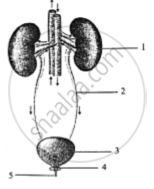Advertisements
Advertisements
Question
The diagram given below represents an organ system in the human body. Study the same and answer the questions that follow :
What is the fluid that accumulates in part 3?
Which is the main nitrogenous waste present in it?
Solution 1
Urine. Main nitrogenous waste is urea.
Solution 2
Urine. Main nitrogenous waste is urea.
Solution 3
Urine. Main nitrogenous waste is urea.
APPEARS IN
RELATED QUESTIONS
Describe the structure of the kidney with the help of a labelled diagram.
Differentiate between the following pairs of term :
Excretion and katabolism
Choose the odd one out in the following serie:
Urea, uric acid, haemoglobin.
Name the following:
Organ which stores urine.
What is osmoregulation?
The human kidneys are located on either side of the vertebral column at the level of ______.
Maximum amount of urea is present in the blood carried by the ____________.
Explain the role of kidney in hormone secretion.
Kidneys are vital organs for survival. Several factors like infections, injury or restricted blood flow to kidneys reduce the activity of kidneys. This leads to the accumulation of poisonous wastes in the body, which can even lead to death. In case of kidney failure, an artificial kidney can be used. An artificial kidney is a device to remove waste products from the blood through dialysis.
i. a. Name the artery that brings oxygenated blood to the kidney.
b. Name the cluster of the thin-walled blood capillaries present in the Bowman's capsule.
ii. In the human excretory system, name the organ which stores urine. Is this organ under hormonal control or nervous control?
iii. List two major steps involved in the formation of urine and state in brief their functions.
OR
iii. In which part of the nephron does selective reabsorption take place? List the factors which the amount of water reabsorbed depends on.
